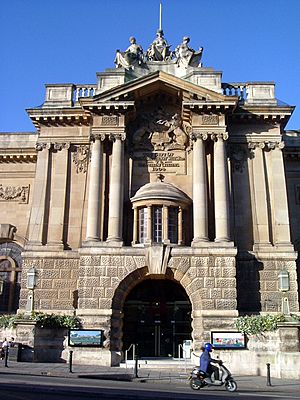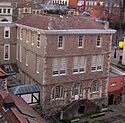List of museums in Bristol facts for kids
Bristol is a city in England with many interesting museums. These places collect and take care of objects that teach us about culture, art, science, or history. They let the public see these collections through exhibits. This list includes art galleries and university galleries, but not museums that only exist online.
Many of Bristol's museums are in special "listed buildings." This means the buildings are important because of their history or architecture. In England, these buildings are given different grades:
- Grade I: Buildings that are super important, sometimes even worldwide.
- Grade II*: Buildings that are very important and special.
- Grade II: Buildings that are important to the country and have special features.
Many museums also meet national standards set for museums in the UK. You'll find all kinds of museums here, like art galleries, science museums, transport museums, and even historic houses. A lot of them are close to Bristol Harbour and tell stories about the city's port history. Some are managed by the city council or groups like the National Trust.
Cool Museums to Visit
| Name | Picture | Area | County | Type | What You'll See |
|---|---|---|---|---|---|
| Aerospace Bristol | Patchway | South Gloucestershire | Airplanes & Space | Aerospace Bristol is an exciting museum about flying! It's home to Concorde Alpha Foxtrot, the very last Concorde ever built and the last one to fly. You can see many other airplanes, helicopters, and even space technology. The museum tells the story of over 100 years of aviation, from early planes to the space race. | |
| Arnolfini | Bristol Harbour | Bristol | Art | The Arnolfini is a cool arts center and gallery. It shows modern art, hosts live music, dance, poetry, and even movies. There's also a special art bookshop and a café. It's in a historic 19th-century tea warehouse right by Bristol Harbour. | |
| Ashton Court | Long Ashton | Somerset | Historic House | Ashton Court is a grand old mansion house and estate. The house started in the 15th century and was changed a lot over hundreds of years. It's now owned by the City of Bristol and is used for events like conferences and weddings. The mansion is a Grade I listed building, meaning it's very important! | |
| At-Bristol | Canon's Wharf | Bristol | Science | At-Bristol is a science and technology center where you can explore and learn. It has exhibits about mechanics, sound, light, computers, space, and the human brain. It used to have a "Wildwalk" with rainforests and aquariums, and an IMAX cinema, but those parts have closed. The main "Explore" area is in a historic railway building. | |
| Blaise Castle House Museum | Henbury | Bristol | History & Toys | Blaise Castle is an 18th-century mansion and estate. It was even mentioned in a famous book by Jane Austen! Since 1949, it's been a museum showing historic household items, toys, old costumes, and even a recreated Victorian schoolroom. It's a Grade II* listed building. | |
| Bristol City Museum and Art Gallery | Clifton | Bristol | Many Topics | This museum is run by the city council and is free to enter! It has amazing collections on natural history, ancient history (archaeology) from Bristol and around the world, and local industry. The art gallery has paintings from different times, including many by famous artists and modern pictures of Bristol. The building itself is a beautiful Edwardian Baroque style. | |
| Clifton Observatory Museum | Clifton | Bristol | History & Views | The Clifton Observatory Museum is in a tower on Clifton Down. It started as a windmill in 1766! Later, in 1828, it became an observatory with a special device called a Camera obscura. This Camera Obscura is still there and you can use it to see amazing views of the Clifton Suspension Bridge and the landscape. The museum also shares stories about the site's past and the artists who used the observatory. | |
| Create Centre | Bristol Harbour | Bristol | Environment | The Create Centre is all about being eco-friendly and sustainable. It has an energy-saving eco-house and is home to groups working on protecting our planet. It's located in a historic warehouse from 1908, which was one of the first big buildings in Britain to use reinforced concrete. | |
| Müller House Museum | - | Cotham | Bristol | Biography | This museum tells the story of George Müller, a Christian who ran orphanages. You can learn about his life and work. They also keep records of all the children who lived in the orphanages, which relatives can look at. |
| Georgian House | Clifton | Bristol | Historic House | The Georgian House is a museum that shows what a typical house looked like in the late 1700s. It was built around 1790 for a sugar merchant named John Pinney. It was also home to Pinney's slave, Pero, and a bridge in Bristol Harbour is named after him. The house has original furniture and even a rare cold water bath! | |
| Glenside Hospital Museum | Fishponds | Bristol | Medical History | This museum is inside a former chapel built in 1861. It shows items from the history of Glenside Psychiatric Hospital, which was once called the Bristol Lunatic Asylum. You can see old medical equipment and drawings by artist Dennis Reed, who painted scenes of life at Glenside in the 1950s. | |
| Kings Weston Roman Villa | Lawrence Weston | Bristol | Ancient History | Kings Weston Roman Villa is the site of an ancient Roman house discovered in 1947. You can see traces of decorated walls, mosaic floors, and even underfloor heating! Many of the items found here are now kept at the Bristol City Museum and Art Gallery. | |
| M Shed | Bristol | Bristol | Local History | M Shed opened in 2011 on the site of the old Bristol Industrial Museum. It's run by the city council and is free to enter. This modern museum explores Bristol's local history, transport, and industries. You can even ride some working exhibits like the Portbury train and the Fire-boat Pyronaut! | |
| New Room | Broadmead | Bristol | Religious History | The New Room was built in 1739 by John Wesley and is the oldest Methodist chapel in the world. It has a special double-decker pulpit and was used as a school and dispensary for poor people. The pews were even made from old ship timber! Today, it also has a visitor center. | |
| Red Lodge Museum | Bristol city centre | Bristol | Historic House & Garden | The Red Lodge Museum is another branch of the Bristol City Museum and Art Gallery. It was built in 1580 and has been changed over the years. It even used to be the country's first girls' reform school! Outside, you can explore a beautiful Elizabethan-style knot garden with plants that would have been grown in the 1600s. | |
| Royal West of England Academy | Clifton | Bristol | Art | The Royal West of England Academy (RWA) is a fantastic art gallery. It was started by a group of Bristol artists in the 1800s. The gallery has a permanent collection with paintings by many famous artists. The building itself is a Grade II* listed building with beautiful marble interiors. | |
| SS Great Britain | Bristol Harbour | Bristol | Maritime History | The SS Great Britain was an amazing passenger steamship designed by the famous engineer Isambard Kingdom Brunel. When it was launched in 1843, it was the biggest ship in the world! It was the first large ocean ship to be made of iron and use a screw propeller. After many adventures, including carrying immigrants to Australia, it was brought back to Bristol in 1970. Now, it's a popular museum ship in Bristol Harbour. |
Museums That Are Now Closed
These museums are no longer open, but they were once important parts of Bristol's history.
| Name | Picture | Area | County | Type | What It Was About |
|---|---|---|---|---|---|
| Bristol Industrial Museum | Bristol Harbour | Bristol | Industry | The Bristol Industrial Museum was located by Bristol Harbour and showed items from Bristol's industrial past. This included things about aviation, car and bus making, and printing. It also covered Bristol's maritime history. The museum closed in 2006, and the new M Shed museum was built on its site. | |
| British Empire and Commonwealth Museum | Bristol Temple Meads railway station | Bristol | History | This museum explored the history of the British Empire and its impact around the world. It opened in 2002 in Bristol's historic old railway station, designed by Isambard Kingdom Brunel. The museum's collections were later moved to the Bristol City Museum and Art Gallery and Bristol Archives in 2012, where they are still used for exhibitions and research. |



















